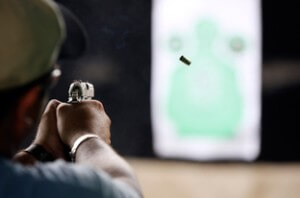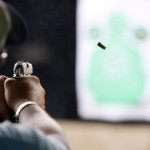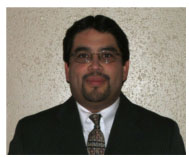You might notice an odd byline on this recent story about concealed handgun permits published by the San Antonio Express-News. I worked on the article, but so did reporters Brandi Grissom and Matt Stiles, who work for the nonprofit Texas Tribune, an entirely separate news organization based in Austin. The same stories, video, maps and photo that ran in the Express-News also appeared on the Tribune’s website.
 As scores of nonprofit, public-service media organizations sprout up around the country, “collaboration” is the latest buzzword in journalism circles. The gun-permit story was the result of the first collaboration between the Express-News, a daily newspaper established 145 years ago at the end of the Civil War, and the shiny new Texas Tribune, which launched nearly a year ago as a web-based source of Texas news and public data. The Tribune’s founder, venture capitalist John Thornton, believes in-depth journalism is a public good — but not necessarily good business anymore. So he joined forces with Evan Smith from Texas Monthly, made the Tribune a nonprofit that relies on donations, and hired top-notch journalists from other newspapers, such as Matt and Brandi.
As scores of nonprofit, public-service media organizations sprout up around the country, “collaboration” is the latest buzzword in journalism circles. The gun-permit story was the result of the first collaboration between the Express-News, a daily newspaper established 145 years ago at the end of the Civil War, and the shiny new Texas Tribune, which launched nearly a year ago as a web-based source of Texas news and public data. The Tribune’s founder, venture capitalist John Thornton, believes in-depth journalism is a public good — but not necessarily good business anymore. So he joined forces with Evan Smith from Texas Monthly, made the Tribune a nonprofit that relies on donations, and hired top-notch journalists from other newspapers, such as Matt and Brandi.
The folks at the Tribune offer their content for free to anyone who wants to republish it, and they’re eager to collaborate with other news organizations. The Tribune got a cold reception at a few Texas newspapers, but my bosses were always open to the idea of teaming up with the Trib. Their attitude was, if there’s a good story and it makes sense to work together, let’s do it.
One idea was to write about data kept by the Department of Public Safety that showed how many concealed handgun permits are issued for every ZIP code in the state. When you view the data on a map, it shows the affluent North Side of Bexar County had higher rates of permits issued than neighborhoods close to downtown San Antonio, where crime rates were higher. It was a curious pattern that occurs in every major Texas city, and Matt asked if we were interested in teaming up on a story about it.
We started working together in early September. Before this project, I knew Matt and liked his work. I didn’t know Brandi personally but liked her work, too, especially this story and this story. And I liked how the Tribune got people excited about investigative journalism. The owners were building something new, not looking for new ways to downsize and cut costs like every other newspaper in the country. It was a nice change.
Read more: How to make stunning time-lapse videos: Q&A with photojournalist Tamir Kalifa
Brandi, Matt and I relied on conference calls, e-mails, and Google Documents to share material and ideas. Both the Tribune and the Express-News have talented staff who could have done this story on their own. But by teaming up, we were able to throw more people at the story, gather more information, finish it faster, and reach a broader audience. Matt called it a “force multiplier.”
One thing that worked well for us was having a clear division of labor. I did the shoe-leather reporting in San Antonio and interviewed gun instructors here; Brandi interviewed people and experts in other parts of Texas, and Matt handled the data analysis. I wrote some early drafts using Google Documents so we could all work on the stories. Brandi plugged in information she gathered and beefed up the articles, especially the one about the surge in gun permits during the Obama administration.
The Express-News benefited from this arrangement. If I had worked on the story by myself, maybe I would have thought to interview the gun owners, experts and public officials Brandi spoke with — but maybe not. And who knows if I would have had the time to do all that. And we also tapped into the power of the Texas Tribune’s awesome data library. By teaming up with the Tribune, the Express-News posted some cool interactive maps created by Matt. That’s a tangible feature that might not have been there for our readers if the Express-News handled the story by itself.
By teaming up with the Express-News, the Tribune got an extra reporter out of the arrangement and benefited from one of the primary strengths of the newspaper, which pays reporters to spend weeks or even months to work full-time on a story. I hung out at shooting ranges, attended two concealed handgun classes, shot some video, and interviewed gun owners and gun instructors.
All this time spent “hanging out” helped me collect telling details and colorful quotes that enriched the story, and I learned a lot about the issue. I liked how a folksy gun instructor, Michael Arnold, quoted the Chinese military genius Sun Tzu to tell his students the importance of using force as a last resort.
Several other Express-News staffers helped out. While I was at a shooting range, Photographer Edward Ornelas shot some cool photos — I love the shot of the shell casing flying out of a pistol. At the office, Database Researcher Kelly Guckian crunched crime data we had to add some context to the story. And graphic artists Harry Thomas and Michael Fisher used the maps created by Matt for the print edition.
What this all means is that in an age of shrinking newsrooms, collaboration briefly augmented the Texas Tribune and the Express-News. And the results most likely surpassed anything the two organizations could have accomplished on their own in the same time frame.
Pitfalls: Coordinating the data-heavy graphics was a bit of a pain. It’s not like Matt could simply walk across the Express-News newsroom and talk to our graphics people. It took some back and forth to get everything right. Maybe we stumbled upon an actual use for Google Wave to deal with that.
Related: A review of the Sigma 17-70mm lens for videographers
I asked Matt and Brandi, who left large corporate newspapers to join the more nimble and experimental Tribune, whether it was a pain dealing with mainstream newsrooms again. They said so far, so good. The gun story got pushed back a week because the Sunday print edition of the Express-News was jammed up with other stories. That’s not a problem the Tribune has to deal with. In this case we thought it was OK because it gave us some breathing room to keep working on the story and make it better.
Overall though, we’re pretty jazzed about the way it all worked out — and we’re talking about our next cool project.




@John_Tedesco Very cool – we’ve been discussing this very topic in classes.